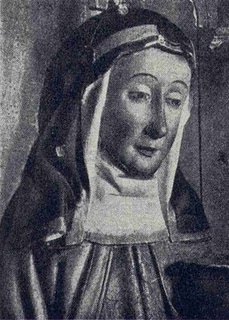
SAINT CATHERINE OF SWEDEN Virgin, c.1330-1381 This saint is the daughter of an even more famous woman-Saint Bridget (Birgitta) of Sweden. Catherine, who was born about 1330, was a married woman who, with her husband, took a vow of continence. She went to Rome in 1348, where her mother had gone after the death of Catherine's father. Catherine's husband died after she had been in Rome a short time, and for the next twenty-five years the two women used that city as a base for pilgrimages to a variety of places, including Jerusalem. When not on pilgrimage, they spent their days in prayer and meditation and in working with the poor and instructing them in religion. This seemingly quiet life was not without perils and adventures. Dissolute young lords repeatedly sought to seduce the Swedish princess, but God's providence unfailingly thwarted their efforts. After the trip to Jerusalem, Bridget died, and Catherine took her mother's body back to Sweden, burying it at Vadstena, in the convent of the Order of the Holy Savior, which Bridget had founded. Catherine became superior of the order and died on March 24, 1381, mourned like her mother by the whole of Sweden.
Swedish noblewoman
Catherine of Sweden, Katarina av Vadstena, Catherine of Vadstena or Katarina Ulfsdotter (c. 1332 – 24 March 1381) was a Swedish noblewoman. She is venerated as a saint in the Roman Catholic Church. Her father was Ulf Gudmarsson, Lord of Ulvåsa, and her mother was Bridget of Sweden (known as Birgitta Birgersdotter of Finsta in her lifetime).
Life
At the age of twelve or thirteen she married Lord Eggert van Kyren, a religious young nobleman of German descent, whom she persuaded to take a vow of absolute chastity, and both lived in a state of virginity. Catherine accompanied her mother to Rome in 1349 and soon upon arrival heard news of her husband's death. Catherine is said to have written a devotional work titled Consolation of the Soul (in medieval Swedish Siælinna tröst, or Själens tröst in modern Swedish); a dated copy from 1407 is still in existence.
She stayed on with her mother, accompanied her on several journeys, including one to the Holy Land. At the death of Bridget, Catherine returned to Sweden with her mother's body, which was buried at the monastery of Vadstena. Catherine became head of the Brigittine convent at Vadstena Abbey, founded by her mother. Catherine took on the task of forming the community in the rule her mother had written and directing the Order of the Holy Savior, or Bridgettines. Later, she returned to Rome to work for her mother's canonization. She stayed there five years and formed a close friendship with Catherine of Siena.
Sainthood
In 1484, Pope Innocent VIII gave permission for Catherine's veneration as a saint and her feast was assigned to 22 March in the Roman Martyrology. Catherine is generally represented with a hind (female red deer) at her side, which is said to have come to her aid "when unchaste youths sought to ensnare her".
In 1488, Pope Innocent VIII gave permission for the translation of her relics in Vadstena. The formal beatification and canonization process, which also documented the required miracles, was never completed because of the Protestant Reformation.
In the Church of Sweden the feast of St. Catherine (Katarinamäss) is celebrated on 2 August.





